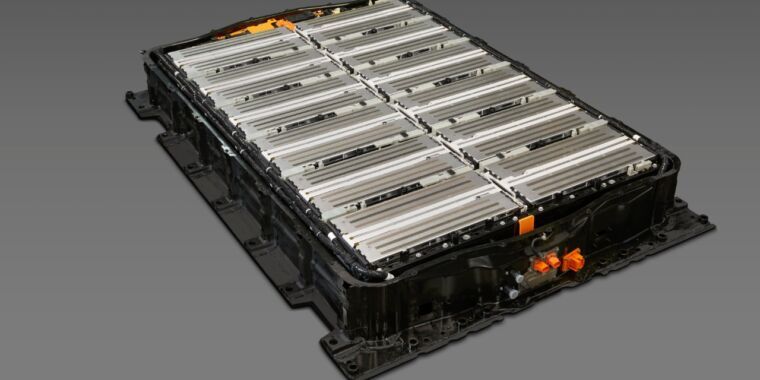- cross-posted to:
- [email protected]
- cross-posted to:
- [email protected]
Honda says making cheap electric vehicles is too hard, ends deal with GM::The platform was to use GM’s Ultium batteries.
So, like all the others, while China will produce cheap eCars. Look, I don’t want to predict the future, but if I only have 20-30k for a new car, I simply physically can’t buy a 60k SUV. You can’t jump into a saturated market of other car companies, who almost all seam to want only expensive eCars and expect a good outcome. There’s only so much money in the pockets of people and only so much people are willing to pay for a used eCar, if it needs expensive battery replacement soon. Not going to happen. Build cheaper cars or fail.
Not to mention not everyone has a garage or nearby charging spot to charge an ev.
Perhaps dealing with infrastructure first would be interesting…
Then again, I don’t have a gas station in my backyard either…
Shopping centers/grocery stores need more charging stations, that’s the most realistic place to go to charge when you don’t have the capacity to do it at home.
Workplaces too.
I cannot even charge my phone at work under Italian law (I’m a public employee and it would count as malversation).
Wow that’s a bit of a stretch 😂
Man I haven’t learned a new word in a long time, and “malversation” is a great one.
My workplace is adding free EV charging installed at my closest building for those who work in person still. It definitely seems like a smart idea.
The issue is charging takes a while, while refuelling is pretty much instantaneous
90% of people can charge their car enough in between Shopping trips
People that live in the city don’t usually go shopping with their cars (at least here in central Europe) and people in the countryside will have enough space for a charger anyways.
People do everything in their cars in the U.S.
Yeah, and not being Amercian is a crime on the internet, I know.
DC fast charging is fairly fast. My car goes from 10-80 in less than 20 minutes in summer, and probably 35 minutes in winter. My wife spends more time than that in grocery stores weekly.
4 times longer refueling is crazy that’s only 80 percent versus 100 % refueling.
The point is that you’re already parking your car for that much time while you’re doing other things. They just need to put more charging stations near those things.
4 times longer refueling is crazy that’s only 80 percent versus 100 % refueling.
Imagine instead every week having to make a special trip with your vehicle to a designated location where you have to interact with a point-of-sale that is trying to upsell you car washing services or loyalty program enrollment with a good chance of skimmers installed on credit card readers.
You then have to dispense gallons of fluid of highly flammable liquid which you, in the week ahead, will turn into carbon dioxide that will slowly alter the climate of your planet to the point that hundreds of species of plants and wildlife die off.
On the financial side, the price of the liquid is so variable that it can change multiple times a day based on market demands and world events. Your country may go to war to ensure you getting that liquid. There will be deaths of your countryman to make sure you get that liquid.
Instead, I pull the car into the garage and plug a cable in. When I get in the car the next day, its full. So yes, one of these sounds crazy, but not the one you say it is.
Your privilege is showing. I live in an apartment so I would have to make a separate trip and sit around for 40 minutes to fill the car up 80%…
Even if we’re talking road trips, after 4 hours of driving (often much less), you’re going to want to get out, stretch, pee, and get a bite to eat. All stuff that easily takes 20 minutes.
4 hours at 70mph is 280 miles. Add 20% for not charging all the way (which is faster and is easier on the battery). Add another 20% for cold weather. That gets us to about 400 miles. EVs on the market now are hitting 350 miles, and that number is only going up in the next few years.
EVs past 350 to 400 mile range only serve a small section of the population that likes to pee in a bottle and eat sandwiches prepared ahead of time so they can go 7 hours at once. Most ICE cars don’t have that kind of range. We don’t need to wait around just to serve this handful of people. In fact, we should keep to around 350-400 miles and use any further advancements to reduce weight.
True! I’m more at the 2 to 3 hours get out and stretch kinda point in my life. The amount of chargers and the fact that I can’t do it at my apartment is still a deal breaker.
Well, you also have to account for the fact that you’re not supposed to completely charge (or discharge) a lithium battery pack. 80% is effectively full (if you care about cell longevity)
e: Li-Ion to lithium
The idea is that you charge when you go somewhere with a parking lot where you are staying for more than a few minutes. Almost everyone whose primary mode of transportation parks somewhere and then spends 30+ minutes inside, whether that be restaurants, grocery stores, work, or somewhere else. In that time I get get 200 miles of range, which is far more than I actually use most weeks.
The goal is, to set them up so people aren’t necessarily waiting.
– I don’t care how long it takes to charge at home: just like my phone I plug in overnight and it’s fully charged in the morning
– all the grocery stores and restaurants and workplaces that have chargers are all pretty slow but you’re going to be there for a while anyway, plus they only need to recover the charge used to get there
– on road trips, my stop is well under an hour but a supercharger can give back a good percentage of charge in that time
“Barring about this one minor annoyance, EV’s are great!”
That’s why NIU’ system with swappable batteries is a great idea, even though it makes engineering more difficult
I either charge at home, or at work, or if there happens to be a charger at my destination but I’m almost never waiting to charge.
I’ve frequently had to wait for a pump or had to go out of my way to get to a working pump. Gas pumps don’t work when the power goes out but batteries stay charged. I’ve actually had to load up my gas generator in my ev to drive 2 towns over during a power outage to get fuel…to keep my pets alive. Car only had about 30% charge to start and roughly 22% when I was back. Generator had 0 gas to start (had just run through my old gas) and was full when I got back…also the power decided to come back on which began refueling my ev.
Good point. It’s a sort of chicken egg problem. Lack of ev and no investment for infrastructure, resulting in even less ev.
Here in Germany, in my local town, they build hydrogen fuel stations instead of charging stations. Very strange.
Hydrogen may not be such a bad idea until there’s electrical infrastructure. Hydbrid hydrogen-electric even?
Hydrogen cars are basically hybrids already. Hydrogen has some issues though that are unlikely to be overcome. Go watch a video of someone driving one around, if you think finding an EV charger is difficult, just try finding a hydrogen charger outside of southern California.
There are two types of hydrogen cars: Fuel Cell EVs and ICE built to run with hydrogen fuel. Both of them are the future of fuel. You won’t see a network of EV charging stations in most south american, african, or Asian countries. The EV revolution is very urban focused. Hydrogen as a fuel that can be transported almost as easily as gasoline is the pragmatic future. EVs are popular because Elon Musk went viral.
Edit: totally aware it’s not successful at the moment: https://www.motor1.com/news/693449/toyota-hydrogen-mirai-not-successful/
Hydrogen doesn’t solve any problem. It’s just a secondary set of infrastructure we’d have to invest in, and it doesn’t overlap with BEV infrastructure (excepting for some grid improvements).
Planning on a 1-to-1 swap between traditional cars and EVs is the crassest mistake. It would take a paradigm shift that emphasizes remote work, carpooling and carsharing in order to make private transportation really sustainable.
EVs are here to save the car manufacturers, not the planet. Literally just a bandaid solution to kick the can of actually implementing the harder solutions that require some societal change down the road a few more years
You can’t have infrastructure without the cars, and you can’t have the cars without the infrastructure. The solution to this catch-22 is to force the infrastructure to catch up.
Or maybe instead of blocking everything on the theory a complete charging solution will magically appear despite no demand, we can go ahead with the 59% of the population living in a house, and can decide to install a charger. Maybe we can go ahead with charger networks we already have, already allowing most road trips and getting better continuously. And we can use all that demand, all that money to keep building out a better and better charging solution.
FYI - buddy of mine has an EV at a townhouse with no opportunity to charge, and just goes to a supercharger once a week to top off. It may be inconvenient, but it’s not onerous
Charging infrastructure is getting better. I’ve had an EV without home charging for three years now and I’ve managed just fine. Overall it’s no more inconvenient than having to go to a gas station.
I have a plug-in hybrid. I try to charge while running errands. I (almost) never can. In my area, most stores don’t have chargers and those that do, typically have a slow charger with 2-4 spots. Those spots are always taken.
I hope to see more cheap cars by 2025 when VW starts doing their id1 and id2. The rest of the manufacturers need to follow suit or lose out of the massive market for mini and micros.
Personally I did get a used EV. It had driven less than 200km in total, but I got it at about 70% of the normal price. The battery is fine. The used market isn’t just for worn out cars. People sell almost new cars for a variety of reasons, so it’s worth looking at the used market already. The batteries in modern cars are generally better than their reputation. I wouldn’t want to get a 7-10 year old EV, but anything newer is just fine.
Used / 200km
Bwahahaha that’s not used. That’s new. Talk to us again when you pick up a car with 50 000 on it.
I mean, that’s my point. The used market isn’t all beater cars. There are almost new EVs available on the used market. 3 years ago they didn’t exist at all. The used market back then only had EVs with poor batteries, but these days you can find new cars in the used market with new batteries, but still at a massive price discount only for being used slightly.
Many people still have the common idea that used EVs are risky, so the prices drop a lot from very little use. Also because the technology in new cars evolves very quickly, so you can get last years models considerably cheaper.
I picked up a used EV with about 20,000 miles on it and it still felt like new.
My EV has almost 70,000 miles on it, and it drives like it’s new. The seats and the suspension aren’t quite there though.
My current (ice) vehicle I got with about that and it also was practically new. Only problem was a chip in the windshield that I had to get replaced when it grew into a large crack, and we honestly aren’t certain if that even predated our purchasing the vehicle
Electric cars don’t normally need a battery replacement during the car’s lifetime. If the battery needs to be replaced, the car has usually already been running longer than most ICE cars ever would. The used market for EVs used to be pretty dire, with little supply and awful pricing. But it’s slowly getting better. But of course the fact remains, that there is currently a lot of demand for cheap EVs and little supply. The Chinese are gearing up to eat up that part of the market.
What?
Show me a battery that goes 200k - 300k.
Just because the average consumer is an idiot and replaces cars long before then doesn’t mean the vehicles can’t go that far.
Every car my family has owned for the last 30 years has gone at least 200k, some 300k+. My current 2005 vehicle is at 270k, and I expect many more years from it, barring an accident. Our newest vehicle is from 2016, and is approaching 100k. An electric vehicle would be needing a battery soon, while all mine needs is an oil change, and perhaps a timing belt for $50 (to be fair, I’ll probably spend $250 and replace the water pump, idlers, and primary belt while I’m there. Last time was 100k miles ago).
I can keep you updated on my own EV ownership if you’d like. I bought a '22 Chevy Bolt brand new for $27k a hair over 12 months ago and so far it’s got 51,000 miles on the odometer and the battery has lost only 10 miles of range compared to the 240 it came with, which is such a small loss it might actually be due to the wind or temps on my test since I do my range tests on the freeway during road trips. Despite driving on average more than 137 miles every single day in this EV during the summer, rain, winter, and multiple snow storms (yay Midwest -_-), the battery seems to be holding up pretty well. My plan is to drive the car for at least 5 years before considering a replacement, at which point I should have between 230-270k on the odometer. The only maintenance items on the car are tires every 50-60k, new coolant in the coolant loops every 150k, brakes every 100k or whenever they wear out (which varies wildly based on how an EV is driven), and wipers + wiper fluid as needed.
My goal here isn’t to put you on blast or call you a liar because skepticism is fair. I’m just sharing my own experience so far with a car that runs on EV tech last updated in 2015. I was pretty worried the “abuse” I’d be putting it through with my driving would cause it to have problems or perform worse than it should, but so far it’s doing great and the battery isn’t any worse for wear than other Bolts who have published their numbers online.
Personally I’m really looking forward to finding out how well the 2022+ Tesla Model 3s do with the new LFP battery because supposedly they’ll be a big improvement over the NCM batteries they have been using (which my car also uses) when it comes to longevity and being left alone for really long periods of time (months, years).
The next Chevy bolt will also have LFP batteries, so they should have similar performance. I think the benefits of LFP outweigh the NCM and that they have a higher life expectancy, can charge to a higher rate with less degradation, although they don’t like really cold weather.
My M3 with LFP battery had almost no range loss in its first winter last year, although last year was milder than normal in the NE USA
And if Chevy actually gives drivers the option to manually precondition the battery, your last point would be much less of a negative.
EV batteries are lasting longer than expected.
Also, when accounting for maintenance over, EV’s can be cheaper over time even with a battery replacement. They don’t need oil, engine coolest, or transmission fluid. There’s a whole life support system for ICE cars that EVs just don’t have, and what replaces it tends to last indefinitely if there are no manufacturing defects or have an abusive owner. Brake maintenance is also reduced; they need the fluid changed, but regen braking tends to reduce the need to replace pads. Manufactures were already seeing pads and rotors on hybrids last nearly the life of the vehicle.
It all adds up, and while the $10k battery cost years down the line scares people as one big number, it often ends up being less than what you would have spent on maintenance over the same time period.
Finally, the batteries may not be worthless at the end of that time. Putting them in houses for backup power is often still feasible. You’re just not getting the same range out of them anymore.
Aside from the Leaf, which does not have any sort of battery temperature management, I wouldn’t expect an EV to need a battery so soon.
Teslas can easily make it to 200k miles at while retaining >80% of peak capacity, according to
.
Most of the other brands don’t have enough vehicles approaching that milestone that I could find data on.
Yeah, I don’t know why you think this, but there are plenty of EV taxis out there with 200k miles on them.
And they don’t need oil changes, timing belts, spark plugs, idlers, water pumps or primary belts. And their brakes last easily twice as long thanks to regenerative braking.
So, after about 300k miles, you recycle your battery pack and get a 3rd party one installed for $5k-$10k and go for another 200k miles.
My 2008 Prius has ticked over 200k with the original battery pack. Sure it’s only a hybrid instead of a full on EV, but it’s going strong.
My longest lived ICE car was my Delta 88. 261k before the second shitty GM transmission gave out. The first one died at 180k and was slippy from 120k.
EVs in the US generally come with an 8 year/100k mile battery warranty.
That being said, most of the failed batteries are with early gen Nissan Leafs.
Battery degradation is by and large a non-issue, and newer battery chemistries will easily allow 1 million miles with ~70% battery health.
Why does it have to be new? Whats wrong with a nearly new car that is only a couple of years old? Warranty, at least in Europe covers the major components like body shell and battery for 7 to 10 years now.
Part of reducing the impact of cars to the environment is making them last longer and EVs have the opportunity to be fully refurbished at what would have been the end of their normal lifespan to better than new. Replacing the battery pack for a more modern and denser version, replacing the motor for a more efficient and powerful one, even replace the entertainment unit with a more modern one. Sure, this is expensive but you are basically getting a new car for considerably less than a new car.
While I personally think Musk can eat a bag of dicks, the ability to upcycle early Teslas using Tesla parts is very welcome. It needs to be legally mandated that manufacturers have to offer this and end the cycle of scrapping cars.
What you described is already done with ICE vehicles. Engines and transmissions are rebuilt all the time. Even cars that are totaled are typically given a second life.
Ultimately it’s the vehicle’s body and frame that determine when it’s at the end of it’s life. You’re not going to put a new battery in a tesla with a rusted out frame.
Arguably the lifespan could be worse for EVs since replacing the batteries is so expensive (more than a typical engine rebuild) that many probably won’t be willing to put that much money into an old vehicle.
Rarely happens though in practice with ICE cars, average age of a car being scrapped in the UK is about 13 years, average age on the road is about 8 years. Car lifespan has been increasing in Western Europe as car reliability has improved. In general Cars do not rust as quickly as they used to, obviously there will be individual Friday afternoon shit boxes or even entire ranges as with Merc between the 90s and early 2000s. But in general they are light years better than pre 2000s and especially pre 1980s when they could start rusting their first year.
In practice the cost to repair vs. value of the car tends to dictate its lifespan in Europe, it becomes cheaper to replace the car than fix it. This is the cycle we need to end.
Current it tends to be limited to enthusiasts to upgrade the capabilities of ICE cars such as more powerful or efficient engine, etc. I do not see this market changing with EVs, you can already by performance upgrades for Teslas for example, even if I wouldn’t touch these 3rd party performance upgrades with a ten foot pole (outside of things like brakes and suspension).
Retrofitting a much more efficient engine to a modern ICE car is difficult, it requires all sorts of other upgrades to enable it and manufacturers have been busy trying to lock people out, see BMW and their ECU encryption. Retrofitting a larger battery, particularly to earlier cars is reasonably trivial in comparison and the old battery still has value, whereas a knackered gearbox/engine/ecu combo is worth considerably less for the average car.
This should be similar to a right to repair law for EVs that also enables them to take advantage of the latest tech.
I’m the US the average age in the road is over 12 years and the average retirement age is about 20 years now. We don’t have any required extended warranty rules but do require that OEMs produce parts for at least 10 years. Most parts for most vehicles are available from the aftermarket vendors though.
We have similar parts availability but when a job costs £1500 and the replacement car is £1500 with newer tyres and brake discs most just opt for scrapping as it doesn’t make sense to keep the average car.
If you savvy you break the old car yourself and sell off the working parts for more than the value of the whole car.
Final owners just run the car till it breaks or fails it’s MoT and is no longer road worthy then scrap it for a new one. Cars just depreciate faster than they become unrepairable for large amounts of money (see the costs for a proper restore or retromod).
COVID fucked with depreciation for a while with 7sed being more expensive than new for white goods cars but that’s over now and depreciation is huge again.
In my experience, at least in the US, most people aren’t getting rid of their car because a new car is cheaper, they do it because the cost to repair the old car exceeds the current car’s value. This is actually a very poor justification for buying a new car but it happens all the time. People get scared when they get a high repair bill and jump into a multi year auto loan costing 250+/month.
Cars are expensive here though so you’re unlikely to buy new for much less than 20k and the reality is most consumers aren’t buying base model cheap compact cars.
Of course you may be able to buy used cheaper but people who are afraid of repair bills aren’t usually rushing out to replace one old car with another.
It depends on if the car is about to enter an expensive period or not, if its not been looked after and/or is an unreliable model then when one thing goes it will be quickly followed by a whole bunch of other repairs. Cars can rapidly become a money pit and sunk cost fallacy applies very strongly to them. Its usually better to be dispassionate and cut your losses, especially if you can make money back breaking the old car yourself.
New vs. old is a difficult one. If you cannot work on the car yourself then having a fixed cost for a car that all non consumables are covered by the dealer can be very attractive. Plus you can offset some of the consumables costs for the first year or two as they will be brand new on the car. If you have the skills, tools, and time to do it yourself then usually its cheaper for a second hand car assuming you can choose a good one thats been looked after. Far too many people who think they know better know fuck all when it comes to choosing a good used car.
This was very much me when I was buying my first car. I was talked into not paying finance on a nearly new car and instead buying my dads old car that had just failed its MoT. I spent a few hundred fixing it myself and getting it back through the MoT. I then did about 50k in it over two or so years but I had to work on that fucker almost every week and spent thousands doing so. With hindsight the couple of hundred on the nearly new car would have worked out about the same cost and I would have saved hundreds of man hours of labor.
I think that there is a lot more mileage in taking a good old car and converting it to be an EV. Its not going to fit every use case but it is going to replace a lot of the old knackered rubbish that is in older ICE cars and is going to cost significantly less to run for the next decade of use before it needs another big refurb. My dream is to get an early Range Rover and do this to it.
Don’t manufacturers charge something close to the price of a new car to exchange the battery?
Like they based the entire business model around the smartphone model of making them “disposable” so you keep buying new ones
Nope, the typical £10k to £12k on cars costing £30k, something like a Zoe for example, a Tesla Model S is around £20k to £30k depending on size with the Tesla being £60k to £100k to buy new.
The old battery is still worth a significant chunk of change as well, they certainly do not need to go in the bin. We haven’t even started refurbishing old batteries yet, just repurposing them.
Couple that with more modern batteries often being bigger capacity for same sized packaging. Model S 60kwh with 70% usable is approx. 42kwh usable. Upgrade that to 85kwh and you’ve doubled your usable battery, so better than new.
Oh, and you’ll often get another 7 to 10 year guarantee on the battery as well.
So nothing like a phone battery, well maybe one from Apple replaced by apple with an actual enforable warranty
20-30K?! Holy crap. I’ve never spent more than 10K on a car. But then I’ve never bought a new car…
You guys drive? 💀 My rollerblades were only $200 and the ball bearings are in great shape.
Get some nice ABEC 9s in there mm mm
you’ll spent 10k minumum on replacing a battery on a used tesla
I’ve pretty much resigned myself to the fact the only electric car I’ll ever own will be a 10 year old Nissan Leaf.
my car wasn’t even 2K
There’s always one smug dunger driver in the comments.
Let people have nice things, OK?
As trade with North America and China degraded that was one of the worst casualties.
China has a booming market for small EVs. It is not an understatement to say they are years ahead of us in that regard.
What is it North America? Because you said I’m not allowed to have public transit and now I’m not even allowed to have the type of car I want.
Oh boy do I love freedom.
Oil companies invented a psyop in North America centered around male insecurity with their masculinity. That’s why the best selling vehicle in North America is a massive gas guzzling pickup truck that the average person can’t come close to affording but drives anyway.
They’ve also targeted maternal instincts. You can’t get a mother to look at a car unless the hood is taller than someone else’s child.
Also car seats are enormous and don’t fit well into compact cars unless the passenger side seat is all the way up and maybe not even then. Good luck if you have more than one kid that needs a car seat too.
Who said anything about compacts? A modern station wagon would work great inplace of an SUV.
I’m just explaining why parents might opt for a larger car especially if they have multiple children. It used to be mini vans, now it’s SUVs or crossovers which are probably not much bigger than station wagons.
They’re needlessly taller. That’s why I mentioned the hood height. You lose fuel economy and you make it more dangerous for kids crossing at cross walks.
I like when people drive lifted pickups without a speck of dirt in the bed. I call those vehicles the Pedestrian Killer 9000
Pavement princess
Emotional Support Vehicle
Small dick emotional support
The male safe space? :-)
I call them small dick compensators
Emissions regulations apply differently to vehicles of different sizes.
Remember Hummers? I swear it was mostly moms who’d buy it
I remember hummers, but then I got married
Is this innuendo? XD
I forget which gen we were in, but once I was a passenger with a driver who worked sales a Hummer dealership. We were driving back to a summer camp, and as we’re passing the top of what in the winter is the tobogganing hill, he goes “guys hold on, check this out.” He goes offroad down a significant incline, mowing down saplings and dodging trees, rocks, etc, with all of us kids just trying to hold on in the back because the seats lack bolstering. We get to the bottom and he’s just like “cool right?” It was kind of cool, and it’s also what made it the perfect karenmobile.
It also makes up for their obviously small penis as well. Use to be muscle cars.
And here you are, furthering the psyop
You don’t sound like you’re from NA, but here in the US we have trucks that are colloquially known as “Child Killers” because when you’re driving them, you literally can’t see what’s in front of you. They are all over the roads, and make for an extremely bad experience for people in smaller vehicles, people on bikes, and pedestrians. Not to mention, they’re often driven by people that lean heavily into road rage.
Avoid Dodge Ram drivers, especially.
That whole culture is cancer. A lot of Koreans here think country music is typical American music, and i have to explain to them how that whole culture is super, super fucked and how they need to turn off that fucking music
they need to turn off that fucking music
Can I keep Bluegrass music and older country artists like Willie Nelson and Johnny Cash?
(Modern Country sucks.)
Good point. That stuff is chill. I dig me some Johnny Cash now and then, too
Yes and you can also enjoy anyone modern who plays in that style. So many nights me, whiskey, and Johnny Cash. Somehow that multimillionaire loved by all gets me.
My brother drive a 2500, guess it checks out. Huh.
Imho, the problem is that North American roads are not safe for small vehicles. If you’re a suburbanite who spends an hour in your car every day on expressways full of trucks and SUVs, you don’t generally want to be in a slow, tiny, short, vulnerable vehicle where you’re beneath the consideration and sightline and possibly wheels of traffic.
Seriously, in Texas even a full size 4-door sedan feels small compared to all he lifted oversized pickups all over.
Am in Texas (Dallas area) I commute 33 miles each way in an electric Fiat 500. I actually do feel plenty safe (car is insanely stable but also far safer than my other commuter which is a klr650 motorcycle) but do have issues with road rage. I legitly don’t care if someone hits me in this car as it wouldn’t be the first time and I have full confidence I’ll be safe…on the other hand I don’t appreciate how unsafe large vehicles tend to be nor how difficult they can make visibility.
I used to drive semi trucks for a living and I’d personally pick the Fiat over the Freightliner every time.
Right? And sane laws about safe vehicles that would clamp down on these land-tanks would never pass because muh freedoms.
If your vehicle represents a higher risk to other people around you, then there should be firmer laws about driving it safely. Give Miatas a higher speed limit, and F-350s firmer penalties for dangerous driving and speeding.
Ever seen a honey badger?
There’s also the matter of snow in a large part of the country. Any car with less than 6" of ground clearance is going to get stuck all the time. AWD or 4wd saves a you a lot of grief too.
I drive a Prius and I live in Canada, a vehicle with like 3 mm of ground clearance. The trick is to live in a place with actual civilized government that plows and salts.
I live in Chicago. They are good at clearing the main streets, but they don’t do the alleys. They also can’t help burying cars parked on side streets. On top of that the wind causes huge drifts.
Wisconsin here. I drove a dodge shadow, a grand am and then a civic. Only the grand am sucked in snow and that was due to garbage tires.
Where is this winter hellscape you speak of
Chicago. The wind off the lake blows huge snow drifts and the city doesn’t have the manpower to clear the side streets or alleys. If you park off the alley, you will get stuck. If you park on the street, you will get buried by the snow plow and you will get stuck.
No
Removed by mod
I think they mistook the surplus of the no longer relevant older models.
This YouTube Video explains it well. https://youtu.be/8-NcTawauXA?si=hecmaD1CM9OqFQbc
Here is an alternative Piped link(s):
https://piped.video/8-NcTawauXA?si=hecmaD1CM9OqFQbc
Piped is a privacy-respecting open-source alternative frontend to YouTube.
I’m open-source; check me out at GitHub.
Yes I was surprised when this subject came up on a channel I didn’t expect it. He talks about fields of them :
Here is an alternative Piped link(s):
https://piped.video/1SEfwoqKRU8?si=x1t2kNgeMII9a1_w
Piped is a privacy-respecting open-source alternative frontend to YouTube.
I’m open-source; check me out at GitHub.
deleted by creator
Making a cheap car isn’t rocket science, but Americans unfortunately get all this cheap credit and blow it on luxury SUVs/crossovers
Because Americans spend WAY more time in their cars than most other countries and I’ll be fucked if Im spending an hour+ each day in a cheap econo-car.
look, if your car is the backup house wouldn’t you spend more on it?
With the way the economy is going, it may well be many people’s primary house.
they make them in Vietnam too but nobody cares because they’re still expensive and they suck ass
Having spent a lot of time in China, I have not seen a huge uptake on electric vehicles because they don’t have the infrastructure or charging stations for it. That said, I haven’t been there in the last three years or so but I don’t expect that to be changed radically.
I know that the Chinese government has spent a lot of money trying to entice people to buy electric cars by allowing civilians to use the coveted green parking pass that is good anywhere if their vehicle is electric.
This led to some major expansion of their electric vehicle brands. I don’t know what kind of percentage change it is but it’s big enough to shake up their automotive industry.
Although it seems a bit of a weird move to me considering how good their public transport is.
The bus and train in China can be pretty wildin so I get why a lot of people hate using it. That said Guangzhou subway is pretty nice and Japanese like.
I expect with the amount they’re investing in FCEVs that EVs will only last another decade-ish.
Removed by mod
Crazy to see how far behind Japanese car manufacturers are getting these days. Japan disrupted the auto market and made small, fuel efficient, cars popular. Now Honda and Toyota are starting to feel like 70’s Detroit.
Meanwhile Hyundai and Kia are absolutely smashing it (in Europe and Asia) with their cheap, reliable cars
can’t really agree with the “reliable” part but yea, they are affordable.
2013 Hyundai Elantra here. Despite full synthetic oil changes every 5k miles and new filters every year, my engine has now failed for a second time in 100k miles. The mechanic is telling me it needs a new engine, which is going to basically exceed the value of the car.
But at least it was cheap!
Former 2012 Forte owner here - first engine made it to 90k, second one was knocking already about 2k in. Basically walked from a freshly paid off vehicle and bought a Toyota.
Meanwhile Hyundai and Kia are absolutely smashing it (in Europe and Asia) with their cheap, reliable cars
And easy to steal
Edit: Downvote me all you want, I got mine stolen this year in Bulgaria, and if you check the news there’s a lot of Tucsons stolen like every week. Along with the recent callback of models that risk getting on fire, Hyundai has a pretty shit reputation lately and I wouldn’t buy one again even it was free.
I thought only the American models were easy to steal because they left out some critical antitheft features on the lowest cost models? Didn’t think it impacted other countries.
Pretty sure their refering to the fact that certain Kia(?) models could be jacked using a screwdriver and USB. Basically the engines power button was shit. This is also why I dont fucking trust cars that use startup buttons, atleast if someone hotwires the car they had to work for it.
It only affected key start cars, if it was push button start, it was immune to the attack you describe.
I was going off of something I vaguely remembered. But now my question is why the actual fuck was the key start system setup so badly.
My understanding is it doesn’t actually verify the chip on some models and the mechanism to start happens to be roughly the same size and shape as a USB plug. They took a risk and now they’re paying for it with a full recall
That’s a damn good question, when chip-keys were fairly common in the 90’s already.
Not in Europe. That fiasco only happened in the US.
deleted by creator
Because the US doesn’t make engine immobilisers mandatory like the rest of the world does
Hyundai knowingly left an easy exploit to hotwire their cars in for several years. The redesigned a few cars to try to rebrand after fixing it, but they cut corners there too, and now they’re in the middle of recalling the Tuscan for exploding batteries.
Sorry, Hyundai isn’t a role model here.
He is referring to the EV cars as in the topic.
He’s also shifted from NA to Europe. So…
But a Hyundai isn’t going to easily go 200k miles with easy to source parts (have Hyundai cars in my family).
Hyundai and Kia are disposable cars. Not a model I can get behind.
Tradeoffs, it’s always tradeoffs.
They are only disposable to those that don’t take average care of their cars. My parents Sonata is at 235k and it will soon become my kid’s car. Runs fine with no issues because my parents take care and of their cars.
I mean my mom had a Hyundai that got it’s regular maintenance, still died when it had costly transmission issues
Kia and Hyundai are the most stolen cars in North America due to missing basic security measures like steering wheel locks and the ability to spoof the key fob with a cell phone. You could also take a Hyundai or Kia that is near it’s fob and just drive off in it. There was no proximity shut off until a recent OTA update, and it didn’t work on every model
They’re cheap in NA and they’re likely to stay that way until they add proper security measures. In response, both State Farm and Allstate have raised insurance rates on Hyundai and Kia made after 2015. They’re cheaper because they cut corners, and the end customer foots the bill on the insurance side
Prius anyone? Still a better approach than a full electric.
Debatable in today’s world. At least in Europe and north America
PHEV’s are getting reclassified/re-regulated by the EU, because:
-
The stated average emissions are based on actually plugging in to charge, which most owners don’t bother with, considering electric propulsion only accounts for like 1/15 of the cars total range
-
It has been regulated in a way that gave the manufacturer only small emissions penalty for increasing the motor size & weight of the car - because it was still considered to be electrically powered.
-
The design itself leads to a heavier car (having 2 propulsion systems)
Meanwhile, the full EV market has been more self-regulating in the sense that they have kept the weight/energy requirements down in order be competitive on range.
-
I would not say a better approach, but it is a workable one. We have one already and will be getting a second one in the next few months. Our next new car will be an all electric, but that is a few years down the road.
No it’s not.
Last I looked into it, Toyota was still supposed to have some of the most efficient combustion engines out there, with something crazy like 40%(?) thermal efficiency.
As far as I know Mazda are the highest with their gas engines that have diesel compression ratio.
Wow, 56%, impressive, although they seem to be roughly in-line with the competition for MPG anyway.
I know, that’s what I find weird about it, in the end fuel economy isn’t that much better… I haven’t checked peak power vs competition though, but I think they have more torque than most? 🤔
It’s because fuel economy is heavily driven by vehicle weight, since start from a stop kills efficiency. Cruise effeciency is more about aerodynamics than weight (ask anyone who’s ever towed anything - you can really feel the drag above 45mph).
And oddly enough, today’s cars aren’t really significantly lighter than 30 or 40 years ago. We’ve just moved the weight from the frame/body setup to unitized body/frame (lighter but safer… And cheaper to manufacture), more safety systems (airbags/computers) and things like heated seats, etc.
Today’s 4+ seat SUV often weighs as much as a 1970’s 4+ seat station wagon…but with less space inside.
Yes it’s about aerodynamics and rolling resistance and weight and you need X torque to overcome all of that at Y speed, but if you are able to generate that amount of torque from less fuel because your engine manages to extract more energy from the same amount of fuel, you would expect the car to have better fuel economy than its competitor with an engine that has worse thermal efficiency… So unless Mazda is doing something really wrong or the return diminishes greatly past a certain point, I don’t understand why they don’t have much better fuel economy numbers with an engine that has 56% efficiency (compared to as low as 20% for gas engines just 20 years ago!)
How do they pull that off?
16:1 with the latest generation of engines, direct injection does miracles!
How efficient was the Flying Scotsman? That must have had a pretty efficient engine.
At a quick google steam locomotives generally top out at 10%, due to discarding the steam without recovering any of the heat.
I mean I drive a Prius Prime and I love it. I’m surprised they’re not pushing harder on PHEVs. I just put 900km onto the darn thing on a road trip - a few evening charging sessions (the motel had a charging station across the street) for like $3 total plus $35CAD of gas for the whole trip.
We did nothing and tried everything!
So let’s build an unaffordable EV?
They’re saying they don’t care about the cheaper segments and are just going to sell expensive vehicles. I don’t know what those of us who can’t afford 60k vehicles are expected to do for transit though… I suspect this is a ploy to get the American government to subsidize an affordable car range.
We can buy Chinese cars. They are starting to kill it on EV’s, with an already expansive supply chain. It is only a matter of time before they start showing up in the US.
If they get approved by the DOT, which is unlikely both due to government sentiment towards Chinese businesses and the fact of they probably don’t actually meet our safety guidelines
Some of BYD’s models just got 5 star saftey ratings in the EU.
Those super cheap, tiny, death trap looking cars, are mostly just that, but these newer EV companies are making better vehicles. They’ll be in the US soon enough. Safety won’t be an issue.
I see you don’t understand how lobbying works in this country.
There are already cars being built in China being brought into the USA.
All that’s going to happen is these newer companies will need to meet our standards (BYD has proven they can now), deal with some politics bullshit, and end up having to deal with some hefty tariffs that will put them at a disadvantage.
They won’t be completely stopped.
Edit: BYD already has busses running in the USA even.
Cars built in China is not the same thing as cars designed and manufactured entirely in China. And “some politics bullshit” is a hell of a way to describe overcoming the auto and union lobbies in the US.
They just need to get them to stop bursting into flames and they’ll be fine.
Here is an alternative Piped link(s):
https://www.piped.video/watch?v=yOA7qKMcjcE
Piped is a privacy-respecting open-source alternative frontend to YouTube.
I’m open-source; check me out at GitHub.
They’re also heavily subsidized by the Chinese government.
Unless something magic happens and evs get super cheap thats eventually going to end and they’ll just be almost expensive death traps.
Not that they’re particularly cheap at all, but Polestars are already made in China.
deleted by creator
Chinese cars like Great Wall have been a thing in New Zealand for a long time but they’re quite terrible. Chinese built Teslas seem to be reasonably built, but I would steer clear of any cars built by a Chinese brand until there are long term reliability studies.
Amount of time before ban citing vague security risks like car technology could somehow be used by the military…3, 2, 1…
If you’ve ever seen how Chinese manufacturing continually lowers quality despite your contract requiring certain specs, you’d understand the problem.
Lolol and I’m sure the quality will match any day now 🙄
You buy a used car?
Have you seen used car prices?
Meh. That has mostly corrected. Probably 15% up from pre COVID. Down 10% yoy for the last 2 years.
I think as the infrastructure expands, those cheap cars will come. The batteries drive the cost and everyone is putting huge batteries in luxury cars to get 300+ miles of range. But imagine a decade or so from now when charging stations are as ubiquitous as gas stations. Range anxiety won’t be about breaking down on the side of the road. It’ll be about how often you have to stop and wait 10 minutes to charge. At that point, car companies will be able to make affordable new cars just by halving the battery size.
Buy a used car. At some point people started thinking new cars was something for people without money.
But if the base price is 60k and a replacement battery costs something like 30 even used cars are going to be too expensive. You’re thinking like they’re ICE cars where you might be able to buy an old shitbox for 5k and maybe rebuild the engine for the same amount.
I hardly see that happening with these smartphone cars. Lithium battery s would need to get really cheap and a lot of consumer protection laws would have to be passed to keep manufacturers from charging whatever they want for replacing them like they do now.
Don’t buy a 60k vehicle. Batteries are more like 15k installed. Those reports of 30k batteries are edge cases.
Also EV batteries have a life expectancy of 200k miles. Most people consider 100k to be a cars retirement age, so I think the battery problem isn’t as big of an issue as we think. Your car is statistically likely to be worn down or wrecked by that amount of mileage.
Force your City or government to improve public transit options.
My local government keeps refusing to expand public transit options because they say it will increase crime. They’re so fucking racist they don’t want busses and trains to make it easier for people to get around because then the “wrong” people might come to the burbs
Have you seen the size of most US states?
All of England could fit in Alabama (they’re practically the same size). And it’s in the lower half of state sizes.
Great Britain would fit in, I don’t know, Missouri?
It takes sixteen western OECD countries to equal the land mass of the US.
You’re not referring to a specific problem here, and general size isn’t an issue.
The comment you replied to is a bit shortsighted, public transit in more rural areas or small towns wouldn’t work that well.
There’s absolutely room for great public transit anywhere else though, cities and more sizable towns can easily have great public transport and there’s even options for American suburbs. Trains connecting cities together in a lot of areas would also be relatively cheap for most places, and a lot of bigger cities used to have public transport that was eventually torn down to make room for cars.
I think a lot of you forget that things don’t have to be perfect, especially first try and that things can easily be changed.
Do you comute going from NY to LA? No right, so what’s the point?
Doesn’t matter if you live in USA or Switzerland, a city is a city, of course suburban sprawl doesn’t help, but this has nothing to do with the size of the country
Ok. While I am convinced that train is even better than planes I was talking about public transit in cities. And yes I know that conny from the rual area won’t be able to drive 100 miles by bus. But that is not your problem in the us. Your problem is, that you must use a car for 2 miles within the City because you can’t safely walk there.
Same thing they did to housing. Incoming 10 to 15 year car loans.
…you buy ICE until affordable EV is a thing? Is that so bad?
The brands are saying they aren’t/won’t be making affordable EVs because the luxury market is too lucrative. And ICE is done in just a few years, by the time my current hybrid dies ICE won’t be sold
ICE is done in just a few years, by the time my current hybrid dies ICE won’t be sold
You’re delusional if you actually believe this.
And I absolutely guarantee you by the time ICE is not sold anymore, there will be affordable EVs on the market.
Well, they already have that down pat.
That’s a bummer. Was interested to see what a Honda EV with ultium cells would be like. A sub-$30k EV is what a lot of people are looking for, judging from my experience buying a Bolt. Hope they can figure out the unit-economics
Citroen ec3 is 20k although you’re not likely to see in the US I suspect.
I somehow lucked into finding a 2023 Bolt EV at MSRP last year, and got a really good trade-in offer on top of that. It’s been such a great car.
The one dealership that didn’t have a markup near us sold out immediately and we ended paying a slight markup at another place, but after all the incentives and trade-in it was a steal.
We love our EUV, I don’t think I’ll go back to an ICE car after seeing how convenient home charging is and one-pedal driving is great.
I’m a little sad about this - the planned Honda looked nice, the range would have been fine for us (we usually take our pickup on longer road trips anyway), and I was hoping to replace our Mazda 3 with one if it drove nicely and all that. I admit that I had some concerns about the GM underpinnings, though - my experience with American brands is rough, and our experience with GM is the roughest.
We plan to hit the auto shows next year to get an idea of what we want to look at more closely.
The previously announced cars are still releasing.
Oh thanks. I missed that. Still have the GM influence concern though!
I dunno, my Chevy bolt has been a solid
GM had their chances with us. My wife and I each brought a GM into the relationship; they both developed serious transmission problems - among other random issues…and both had much less than 100k miles. They need to show years of reliability before I’d buy another one.
deleted by creator
07’ Civic here. You distracted drivers better not run into me. Please I can’t afford another car.
08 civic and still going strong.
My Chevy bolt still runs. Shoot, it’s cheaper to drive than my 1986 Honda Civic!
This is the best summary I could come up with:
“After studying this for a year, we decided that this would be difficult as a business, so at the moment we are ending development of an affordable EV,” said Honda CEO Toshihiro Mibe in an interview with Bloomberg.
In July, GM had to idle BrightDrop’s production line in Canada due to a shortage of battery cells, and Kelly Blue Book’s sales data for the first three quarters of 2023 show that just 6,920 Ultium-based EVs (which include the Chevrolet Blazer and Silverado EV, as well as the Hummer, Lyriq, and BrightDrop van) were delivered to customers.
GM had said it was ending Bolt production this year at its plant in Orion Township, Michigan, so that it could retool and start building electric trucks beginning in 2024.
The Honda Prologue and Acura ZDX are a pair of electric crossovers that use the same platform as the Cadillac Lyriq and Chevrolet Blazer, and both are still happening.
They’ll even feature Apple CarPlay and Android Auto, which GM has controversially chosen to eliminate from its cars from model year 2024 onward.
And Honda even announced another collaboration with GM earlier today—in 2026, it wants to start operating a robotaxi service in Japan using the Cruise Origin, an autonomous electric vehicle developed by the GM-backed AV company.
The original article contains 606 words, the summary contains 213 words. Saved 65%. I’m a bot and I’m open source!
GM has blamed the Ultium bottleneck on an unspecified “automation equipment supplier.”
Rockwell Automation has entered the chat.
Rockwell is like Comcast. You have no opinion on them or a blind raging hostile opinion of them.
Edit: on a serious note the systems engineering folks have been telling this before my parents were born. This should not have been a shock to anyone. Diversity in components means greater ability to withstanding changes, the tradeoff is you are going to run less efficiently even in good times.
I want to talk about trains.
How about trains but we only use electricity to power them, and let’s say put overhead electric fuel lines over them. Trams. I wanna see more trams. Solves most of the issues EV’s have with batteries.
Conclusion: my next car will be an affordable Chinese car.
Can you import and legally drive those on US roads? I really don’t want to buy a fucking SUV for my next car, but that’s basically the entire electric car market in this country.
The US will probably ban it for geopolitical reasons.
I’m in Europe, BYD already is in this market.
Fossil fuel mafia dumped a large bribe into Honda’s bank account?
Idk, even if you made almost everything out of aluminum , thats like $2000 for the raw metal for the frame and body, 8k for a 80kwh battery, about 5.5k for a 166HP emrax 228 motor off the shelf… with no transmission, the most expensive components combined are less than 20k. I dont see how even a 35k EV would not be profitable with some sensible off the shelf components.
deleted by creator
China does it lol
deleted by creator
































